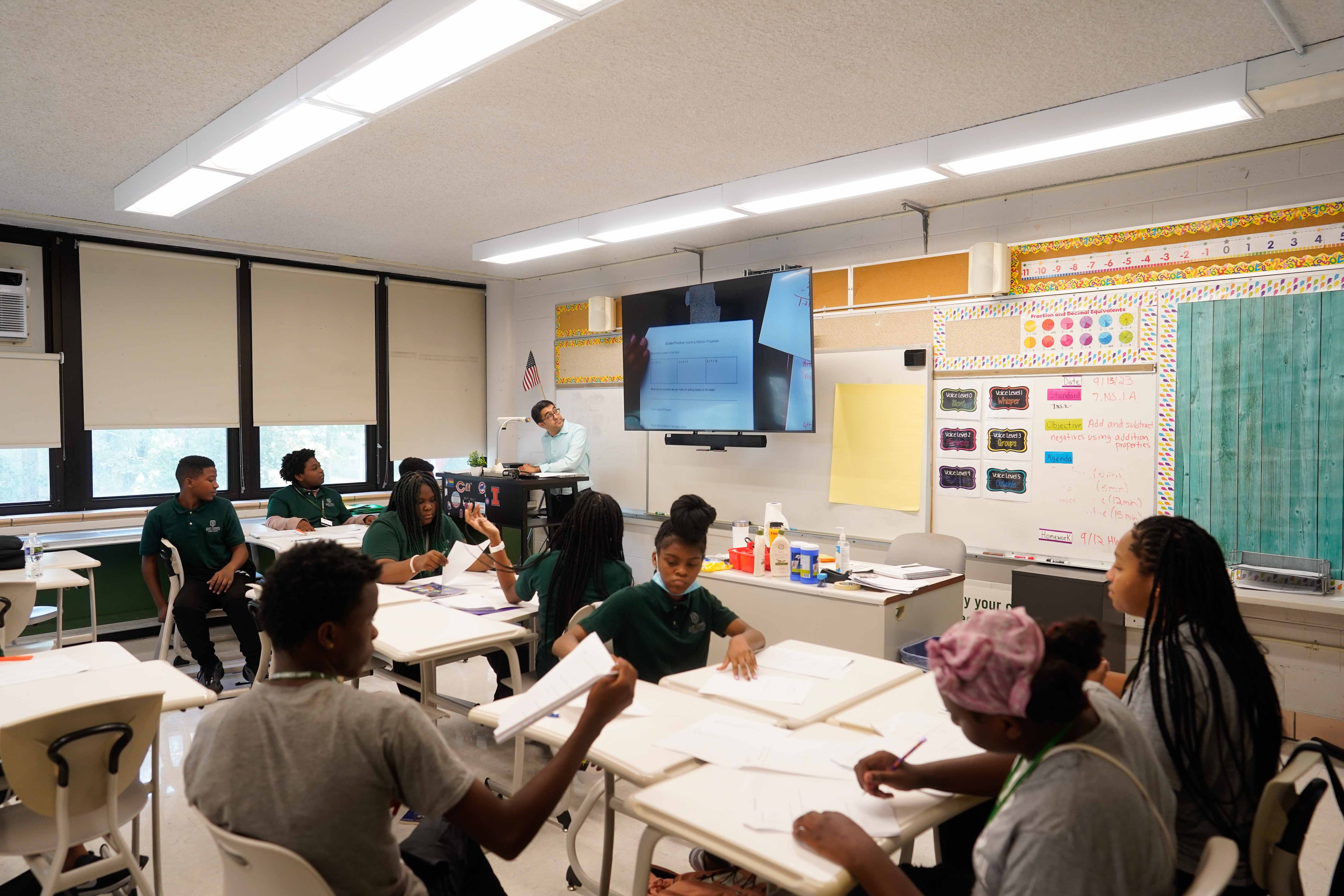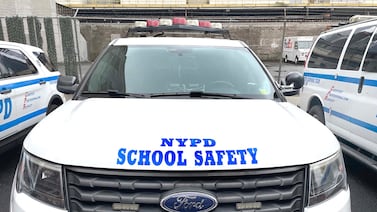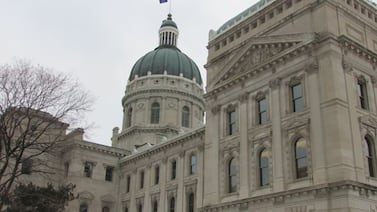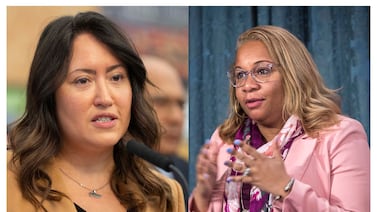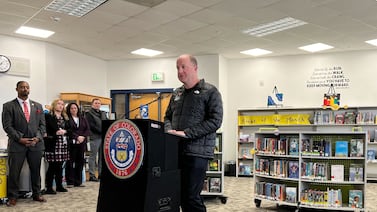Sign up for Chalkbeat Chicago’s free daily newsletter to keep up with the latest news on Chicago Public Schools.
Illinois lawmakers passed a $55 billion budget with slim increases to early childhood education programs and K-12 schools. The lack of new dollars for programs comes as schools grapple with smaller budgets since federal COVID-19 relief expired.
It’s a challenging time for the state government, local school districts, and child care providers. As state lawmakers negotiated the budget during the legislative session, there was fear that federal funding tied to schools could be stripped away. The U.S. Department of Education threatened federal funding for schools that it deems as promoting “illegal” diversity, equity, and inclusion programs. The administration revoked an extension on spending down $77 million in federal COVID-19 relief funds for Illinois schools, but later walked back the decision after a judge ruled against it.
Illinois Gov. J.B. Pritzker praised state lawmakers and leaders in the House and Senate for passing a “balanced budget” in a statement on Sunday.
“Even in the face of Trump and Congressional Republicans stalling the national economy, our state budget delivers for working families without raising their taxes while protecting the progress we are making for our long-term fiscal health,” said Pritzker.
However, local advocates and teachers unions were hoping to see more investment in schools this fiscal year.
Dan Montgomery, president of the Illinois Federation of Teachers, one of the largest teachers unions in the state, said in a statement on Monday that while the approved budget maintains funding levels for programs, it “doesn’t reflect the urgency of students’ needs.”
“Our students in public schools deserve a bold, comprehensive investment, not another year of the status quo. Reducing Evidence Based Funding (EBF) falls short of what is needed to stay on track,” said Montgomery.
Illinois changed how it funded schools in 2017 and promised to get all schools to a higher level of state funding by 2027. But the state is no longer on track to get school districts to their so-called adequacy targets in the next two years. Montgomery suggested it would now take until 2042 and previous estimates suggested it would take until 2030 or later.
The state’s fiscal year will start on July 1.
Here are the highlights from the fiscal year 2026 budget:
Funding for early childhood education remains largely flat
Early childhood education has been a priority for Pritzker’s administration. After winning a second term, Pritzker created the Smart Start Initiative to increase funding for child care programs across the state with the goal of expanding access to child care and preschool programs. Now, there is some concern about what will happen to these programs since many did not receive an increase in funding this year.
The lllinois State Board of Education’s Early Childhood Block Grant, which supports publicly funded preschool school seats, received flat funding this year. The state board was hoping to receive an additional $75 million to support publicly funded preschool seats through the state to bring the program to a total of $823 million. For the state Department of Human Services, Early Intervention, a program for children with disabilities between the ages of 0 to 3, did not receive an increase in the budget approved by lawmakers. Funding for the department’s Home Visiting Program will also remain flat next year.
However, some programs received new funding to support child care for low-income families and child care providers. The state’s Child Care Assistance Program, which provides low-income families with financial assistance to access child care, received an additional $85 million to support more families who will need the program and increase rates for providers. The state’s Smart Start Workforce grants will receive an additional $90 million to help increase pay for child care workers. The state’s Early Childhood Department received a $7.5 million increase for operations.
Jonathan Doster, director of legislative affairs at Start Early, a local early childhood advocacy organization, acknowledged that this was a difficult budget year for the Pritzker administration and the state’s General Assembly.
“With flat funding, it’s difficult to increase wages and benefits for staff. It’s difficult to expand access to early childhood programs. It’s hard to increase the quality of existing programming,” said Doster.
At the federal level, early childhood education programs have been hit by the Trump administration’s actions over the past several months. The U.S. Department of Health and Human Services closed a Chicago-based regional office that provided technical support and funding to child care providers throughout Illinois and several other Midwestern states in April.
K-12 schools receive smallest increase since 2020
The General Assembly’s budget for the Illinois State Board of Education will increase from almost $10.8 billion to almost $11.2 billion.
The final budget includes a $307 million increase for K-12 school districts around the state through the state’s evidence-based funding formula. This is the first time since 2020 that the General Assembly did not increase the budget by at least $350 million.
In previous years, about $50 million of the state’s evidence-based funding formula went towards the Property Tax Relief Grant, a program school districts applied for to receive assistance from the state. A spokesperson from the state board of education said that the grant has been paused and is being re-evaluated to ensure that it is providing relief to local residents.
Illinois’ funding formula for K-12 schools was changed in 2017 to distribute money to school districts based on metrics such as the number of students from low-income families, students with disabilities, and English language learners, and other factors like how much a district can raise through local property taxes. State lawmakers made a bipartisan promise to increase funding by at least $350 million annually for 10 years in order to get school districts to an “adequate funding.” The state is not on track to meet that deadline.
Local education advocates and school finance experts did not believe the state could reach its 2027 deadline by only adding $350 million to the formula each year. Some advocates have been asking for $550 million a year to at least get schools adequately funded by at least 2030.
Advance Illinois, a nonprofit advocacy organization based in Chicago, said that while the state has made efforts to increase evidence-based funding for K-12 schools over the years and more districts are funded well, there is more work to be done.
“Over 1.3 million students still attend schools in underfunded districts – districts that are disproportionately rural and urban and that serve students from low-income households, English language learners, and Black and Latinx students,” said the statement.
Modest increases for higher education scholarships
Illinois lawmakers approved Pritzker’s proposal to increase a scholarship program for college-bound students by $10 million. The latest boost to the Monetary Award Program will support students from low-income families who are planning to attend or already in school. The increase would bring the program up to a total of $771.6 million.
The Illinois Student Assistance Commission’s Minority Teachers of Illinois scholarship did not see an increase this year. The total budget for the program is $8 million, the same as the year before. At the end of the session, state lawmakers tried to rush through a proposal to change the name and eligibility requirements for the scholarship in response to a lawsuit filed by a conservative group in the fall and backlash to diversity, equity, and inclusion scholarship programs from the federal government.
If the proposal had been successful, House Floor Amendment No. 1 to Senate Bill 1331 would have changed the scholarship name to the Teachers of Illinois scholarship. In addition, to be eligible for the scholarship students would have had to have attended a public school district where at least 70% of students are eligible for free or reduced lunch or have gone to a school district that has a three-year teacher vacancy rate at or higher than the state’s average. This bill could be revived in the veto session in the fall.
This story has been updated with a comment from the Illinois State Board of Education and clarification about the components of the evidence-based funding formula.
Samantha Smylie is the state education reporter for Chalkbeat Chicago covering school districts across the state, legislation, special education and the state board of education. Contact Samantha at ssmylie@chalkbeat.org.

